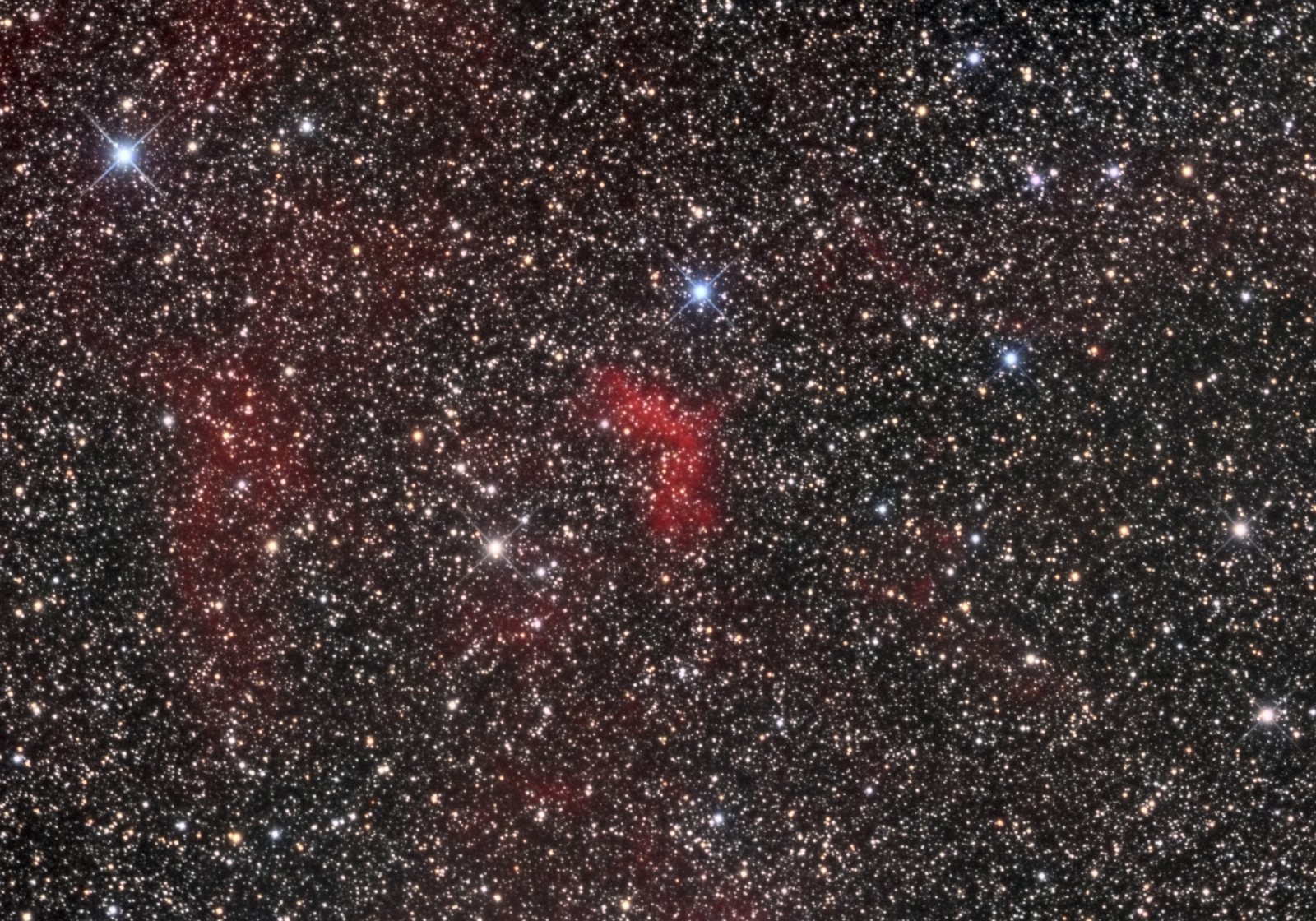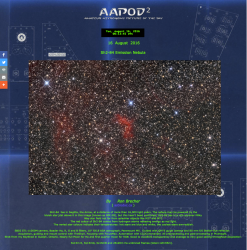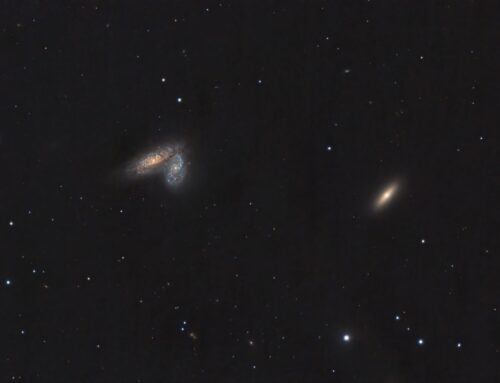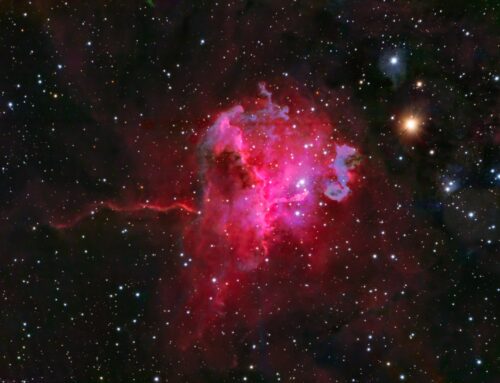Sh2-84 Emission Nebula
 Click image for full size version
Click image for full size version
July 28, 2016, Amateur Astronomy Picture of the Day, August 16, 2016
 Sh2-84 is an emission nebula, another very faint member of the Sharpless catalogue. It lies in Sagitta, the Arrow, at a distance of more than 16,000 light years. The nebula may be powered by the bluish star just above it in this image (known as WR128), but this hasn’t been confirmed. Sh2-84 lies in a rich summer Milky Way star field not far from splashier objects like M27 and M71. Like other emission nebulae, the red colour of Sh2-84 comes from hydrogen atoms releasing energy as red light. The varied star colours indicate their temperatures: hot stars are blue and white; the coolest stars are reddish.
Sh2-84 is an emission nebula, another very faint member of the Sharpless catalogue. It lies in Sagitta, the Arrow, at a distance of more than 16,000 light years. The nebula may be powered by the bluish star just above it in this image (known as WR128), but this hasn’t been confirmed. Sh2-84 lies in a rich summer Milky Way star field not far from splashier objects like M27 and M71. Like other emission nebulae, the red colour of Sh2-84 comes from hydrogen atoms releasing energy as red light. The varied star colours indicate their temperatures: hot stars are blue and white; the coolest stars are reddish.
 The above image blends the red, green and blue colour channels with data collected through a deep red H-alpha filter. The black and white image at right shows the H-alpha data on its own. A full size H-alpha image is available by clicking on the image.
The above image blends the red, green and blue colour channels with data collected through a deep red H-alpha filter. The black and white image at right shows the H-alpha data on its own. A full size H-alpha image is available by clicking on the image.
I have a slightly brighter nebula in the works for my next post – a nice red patch “below” the North America Nebula. I have the H-alpha “in the can” now, and just need a few more clear nights for the red, green and blue… Stay tuned.
Tekkies:
SBIG STL-11000M camera, Baader Ha, R, G and B filters, 10″ f/6.8 ASA astrograph, Paramount MX. Guided with QHY5 guide camera and 80 mm f/6 Stellar-Vue refractor. Acquisition, guiding and mount control with TheSkyX. Focusing with FocusMax. Automation with CCDCommander. All preprocessing and post-processing in PixInsight. Shot from my SkyShed in Guelph, Ontario. Nearly full Moon for Ha and little moonlight for RGB. Good to excellent transparency and poor to good seeing throughout acquisition.
5x15m R, 5x15mG, 5x15mB and 25x20m Ha unbinned frames (total=12hr05m).
HaRGB
Creation and cleanup: Ha, R, G and B masters were cropped and processed separately with DBE. R, G and B were combined to make an RGB image which was processed with ColourCalibration. The NB-RGBCombine Script was applied with default settings to produce a linear HaRGB image.
Linear Noise Reduction: MultiscaleLinearTransform was used to reduce noise in the background areas. Layer settings for threshold and strength: Layer 1: 3.0, 0.5 Layer 2: 2.0, 0.35 Layer 3: 1.0, 0.2 Layer 4: 0.5, 0.1
Stretching: HistogramTransformation was applied to make a pleasing yet bright image.
Synthetic Luminance and H-alpha only:
Creation and cleanup of SynthL: The cleaned up Ha, R,G and B masters were combined using the ImageIntegration tool (average, additive with scaling, noise evaluation, iterative K-sigma / biweight midvariance, no pixel rejection).
Deconvolution: A copy of the image was stretched to use as a deconvolution mask. A star mask was made from unstretched SynthL to use as a local deringing support. Deconvolution was applied (80 iterations, regularized Richardson-Lucy, external PSF made using DynamicPSF tool with about 20 stars; local deringing at 70% and global dark deringing at 0.03).
Linear Noise Reduction: MultiscaleLinearTransform was applied to reduce the noise. Layer settings for threshold and strength: Layer 1: 3.0, 0.5 Layer 2: 2.0, 0.35 Layer 3: 1.0, 0.2 Layer 4: 0.5, 0.1
Stretching: HistogramTransformation was applied to make a pleasing yet bright image. TGV Noise was applied and the image was re-stretched to reset the black point.
Combining SynthL with HaRGB:
The luminance channel of the HaRGB image was extracted, processed and then added back into the HaRGB image as follows:
1. Extract luminance from the HaRGB image.
2. Apply LinearFit using SynthL as the reference.
3. Use ChannelCombination in Lab mode to replace the HaRGB’s luminance with the fitted luminance from step 2.
4. LRGBCombine was then used to make a SynthLHaRGB image.
Final Processing of HaRGB and H-alpha only:
MorphologicalTransformation was applied in Morphological Selection mode to slightly shrink large and medium bright stars. Background, stars and nebula brightness and contrast (HaRGB and Ha-only), and saturation (HaRGB) were adjusted in several iterations using Curves with masks as required.
Image scale is about 1.1 arcsec per pixel for this camera / telescope combination.






Leave A Comment